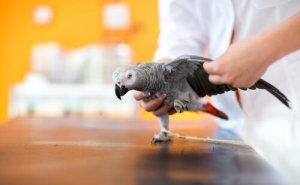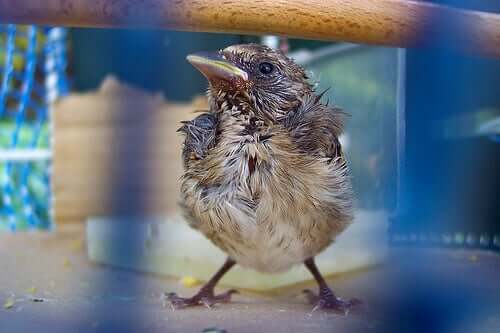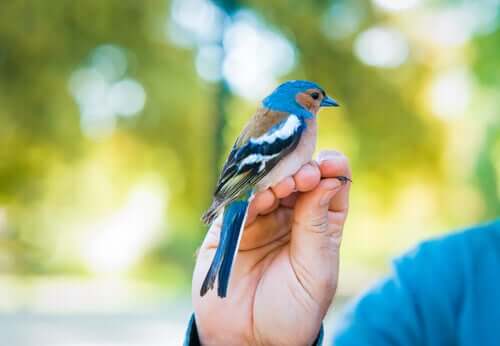Learn all about Treating an Injured Bird


Written and verified by the lawyer Francisco María García
Knowing the correct first aid is fundamental when it comes to treating an injured bird. Thousands of domestic and wild birds are injured daily. The great news is that you can help them!
The leading causes of accidents in domestic birds
Accidental blows are the most frequent cause of domestic bird injuries, traumas, and deaths. They occur commonly when the environment they live in wasn’t correctly prepared for them.
Birds in captivity are also vulnerable to poisoning. It can be caused by the intake of foods, alcohol, metals, or chemicals.
A less common but equally significant risk is when domestic birds get run over when they escape from their homes.

Source: Juan de Dios Santander Vela
Main causes of accidents in wild birds
Large-sized wild birds, such as hawks, eagles, and vultures, can often collide with power lines.
They’re also often the victims due to the practice of sport hunting. Therefore, it’s necessary to raise awareness of the negative impacts of certain human recreational activities on the environment.
Last, but not least, are birds who get run over. These accidents are very common in migratory birds or those whose habitats are crossed by roads.
Among small wild birds, the most common causes of injuries are through falling from their nests. Not all newborn birds develop their power of flight at the expected time and they can fall while trying to fly.
Attacks from natural predators can also wound these animals.
Main first aid measures to treat an injured bird
You can help an injured bird, regardless of its size, if you know proper first aid techniques. Logically, these maneuvers vary according to the cause of the accident.
Firstly, it’s essential to remain calm and proceed consciously when you find an injured bird. You must treat the bird safely, avoiding risks to both your and the bird’s health.
1.Analyze the animal’s situation and condition
Some questions make it easy to recognize the cause of the accident and know what first aid measures to apply to an injured bird. In addition, they can facilitate and guide the work of a specialized veterinarian.
- Is the animal conscious?
- Is there an obvious fracture?
- Does the animal seem to have been run over?
- Is there an external wound?
- Is there evidence of bleeding?
- Do you recognize signs of intoxication?
2.General tips for treating an injured bird
a.Care during handling
It can be dangerous to manipulate a wild bird, particularly large birds of prey. It’s necessary to proceed with caution with them. Imprudent attitudes may aggravate the animal’s wounds or injuries and hurt the person who’s trying to help.
When you don’t have experience handling large birds, it’s advisable to seek professional help. You can call wildlife recovery centers or any other similar local foundation.
b.Avoid aggravating injuries or wounds
A wounded bird is very vulnerable. To avoid aggravating its condition, you should cover it with a blanket, a towel, a cloth, or a piece of clothing.
You should opt for light clothing because heavy material can hurt the bird or cause it pain. The most important thing is to blindfold the bird, because it will calm down when it doesn’t see light.
c.Pick the bird up correctly, avoiding damage
After wrapping up the bird, you can carefully pick it up. It’s important to keep the bird as still as possible. Ideally, you should avoid any struggle.
In the case of evident fractures, it’s very important to place the bird in a natural and comfortable position.
This measure isn’t recommended for birds in a critical condition. In these cases, it’s best to resort to professional help.
d.In case of poisoning
Poisoning in birds is a serious matter and requires specialized attention.

As it’s very difficult to get a bird to vomit, it’s not advisable for you to try it on your own. Ideally, you should immediately take the poisoned bird to the vet.
First aid in case of external wounds
When the bird has small or medium external wounds that aren’t deep, the first thing you should do is clean them with a saline solution or 50% hydrogen peroxide.
In case of deep or bleeding wounds, it’s necessary to act very quickly. Birds can bleed to death quickly. Ideally, you should place astringent powder on the wound and put pressure on, preferably with clean gauze.
During both procedures, it’s essential to grasp the bird firmly. The animal’s natural movement may aggravate their injuries or wounds.
First aid procedures in an injured bird don’t replace specialized veterinary care.
Knowing the correct first aid is fundamental when it comes to treating an injured bird. Thousands of domestic and wild birds are injured daily. The great news is that you can help them!
The leading causes of accidents in domestic birds
Accidental blows are the most frequent cause of domestic bird injuries, traumas, and deaths. They occur commonly when the environment they live in wasn’t correctly prepared for them.
Birds in captivity are also vulnerable to poisoning. It can be caused by the intake of foods, alcohol, metals, or chemicals.
A less common but equally significant risk is when domestic birds get run over when they escape from their homes.

Source: Juan de Dios Santander Vela
Main causes of accidents in wild birds
Large-sized wild birds, such as hawks, eagles, and vultures, can often collide with power lines.
They’re also often the victims due to the practice of sport hunting. Therefore, it’s necessary to raise awareness of the negative impacts of certain human recreational activities on the environment.
Last, but not least, are birds who get run over. These accidents are very common in migratory birds or those whose habitats are crossed by roads.
Among small wild birds, the most common causes of injuries are through falling from their nests. Not all newborn birds develop their power of flight at the expected time and they can fall while trying to fly.
Attacks from natural predators can also wound these animals.
Main first aid measures to treat an injured bird
You can help an injured bird, regardless of its size, if you know proper first aid techniques. Logically, these maneuvers vary according to the cause of the accident.
Firstly, it’s essential to remain calm and proceed consciously when you find an injured bird. You must treat the bird safely, avoiding risks to both your and the bird’s health.
1.Analyze the animal’s situation and condition
Some questions make it easy to recognize the cause of the accident and know what first aid measures to apply to an injured bird. In addition, they can facilitate and guide the work of a specialized veterinarian.
- Is the animal conscious?
- Is there an obvious fracture?
- Does the animal seem to have been run over?
- Is there an external wound?
- Is there evidence of bleeding?
- Do you recognize signs of intoxication?
2.General tips for treating an injured bird
a.Care during handling
It can be dangerous to manipulate a wild bird, particularly large birds of prey. It’s necessary to proceed with caution with them. Imprudent attitudes may aggravate the animal’s wounds or injuries and hurt the person who’s trying to help.
When you don’t have experience handling large birds, it’s advisable to seek professional help. You can call wildlife recovery centers or any other similar local foundation.
b.Avoid aggravating injuries or wounds
A wounded bird is very vulnerable. To avoid aggravating its condition, you should cover it with a blanket, a towel, a cloth, or a piece of clothing.
You should opt for light clothing because heavy material can hurt the bird or cause it pain. The most important thing is to blindfold the bird, because it will calm down when it doesn’t see light.
c.Pick the bird up correctly, avoiding damage
After wrapping up the bird, you can carefully pick it up. It’s important to keep the bird as still as possible. Ideally, you should avoid any struggle.
In the case of evident fractures, it’s very important to place the bird in a natural and comfortable position.
This measure isn’t recommended for birds in a critical condition. In these cases, it’s best to resort to professional help.
d.In case of poisoning
Poisoning in birds is a serious matter and requires specialized attention.

As it’s very difficult to get a bird to vomit, it’s not advisable for you to try it on your own. Ideally, you should immediately take the poisoned bird to the vet.
First aid in case of external wounds
When the bird has small or medium external wounds that aren’t deep, the first thing you should do is clean them with a saline solution or 50% hydrogen peroxide.
In case of deep or bleeding wounds, it’s necessary to act very quickly. Birds can bleed to death quickly. Ideally, you should place astringent powder on the wound and put pressure on, preferably with clean gauze.
During both procedures, it’s essential to grasp the bird firmly. The animal’s natural movement may aggravate their injuries or wounds.
First aid procedures in an injured bird don’t replace specialized veterinary care.
All cited sources were thoroughly reviewed by our team to ensure their quality, reliability, currency, and validity. The bibliography of this article was considered reliable and of academic or scientific accuracy.
- Gobierno de España Guardia Civil (sf). Medio ambiente. Recuperado el 28 de enero de 2022, disponible en: https://www.guardiacivil.es/es/institucional/Conocenos/especialidades/Medio_ambiente/index.html
- Mattiello, R. (2008) Emergencias en aves de compañía. Recuperado el 28 de enero de 2022, disponible en: http://dpd.fvet.uba.ar/cartelera/00007194.pdf
This text is provided for informational purposes only and does not replace consultation with a professional. If in doubt, consult your specialist.








